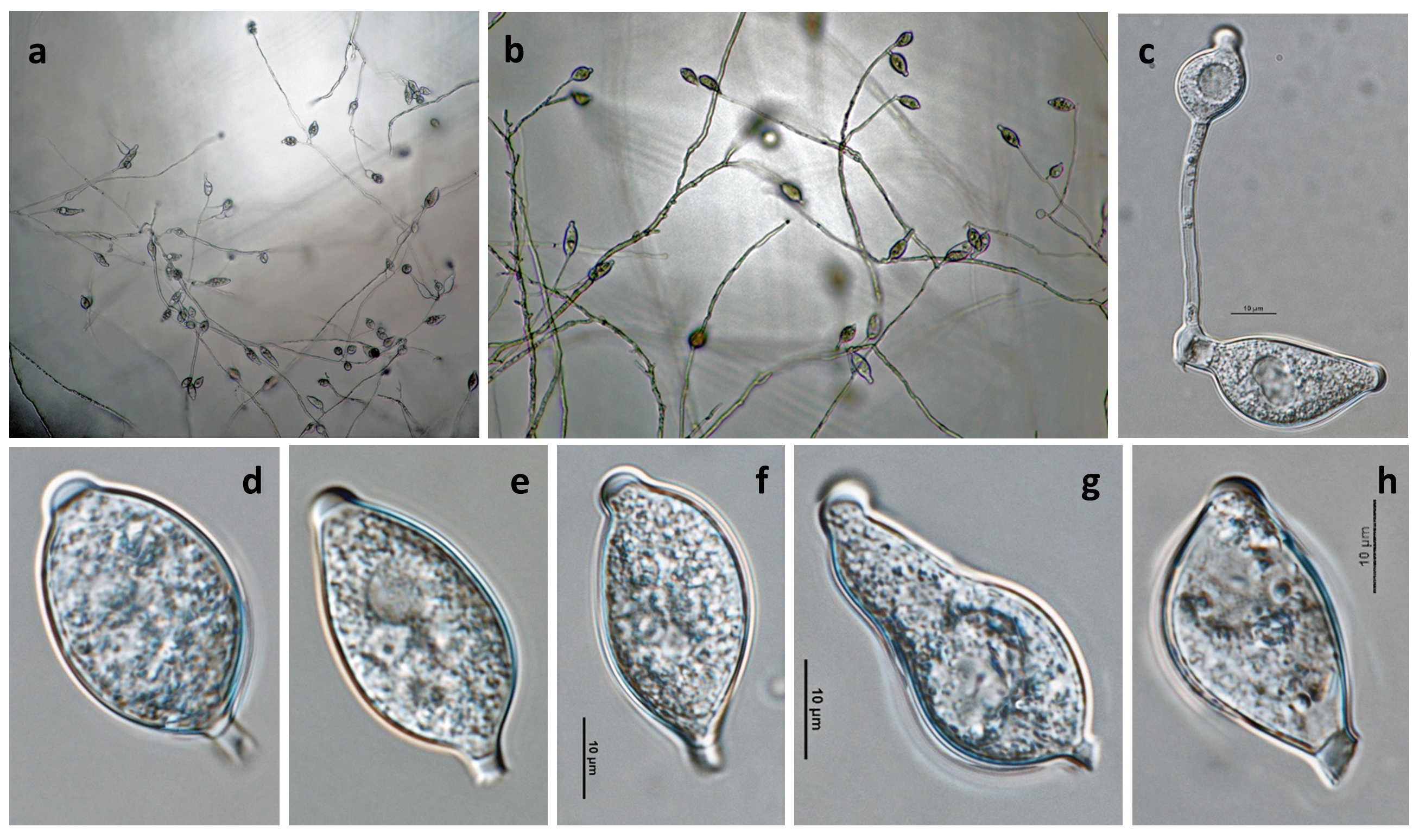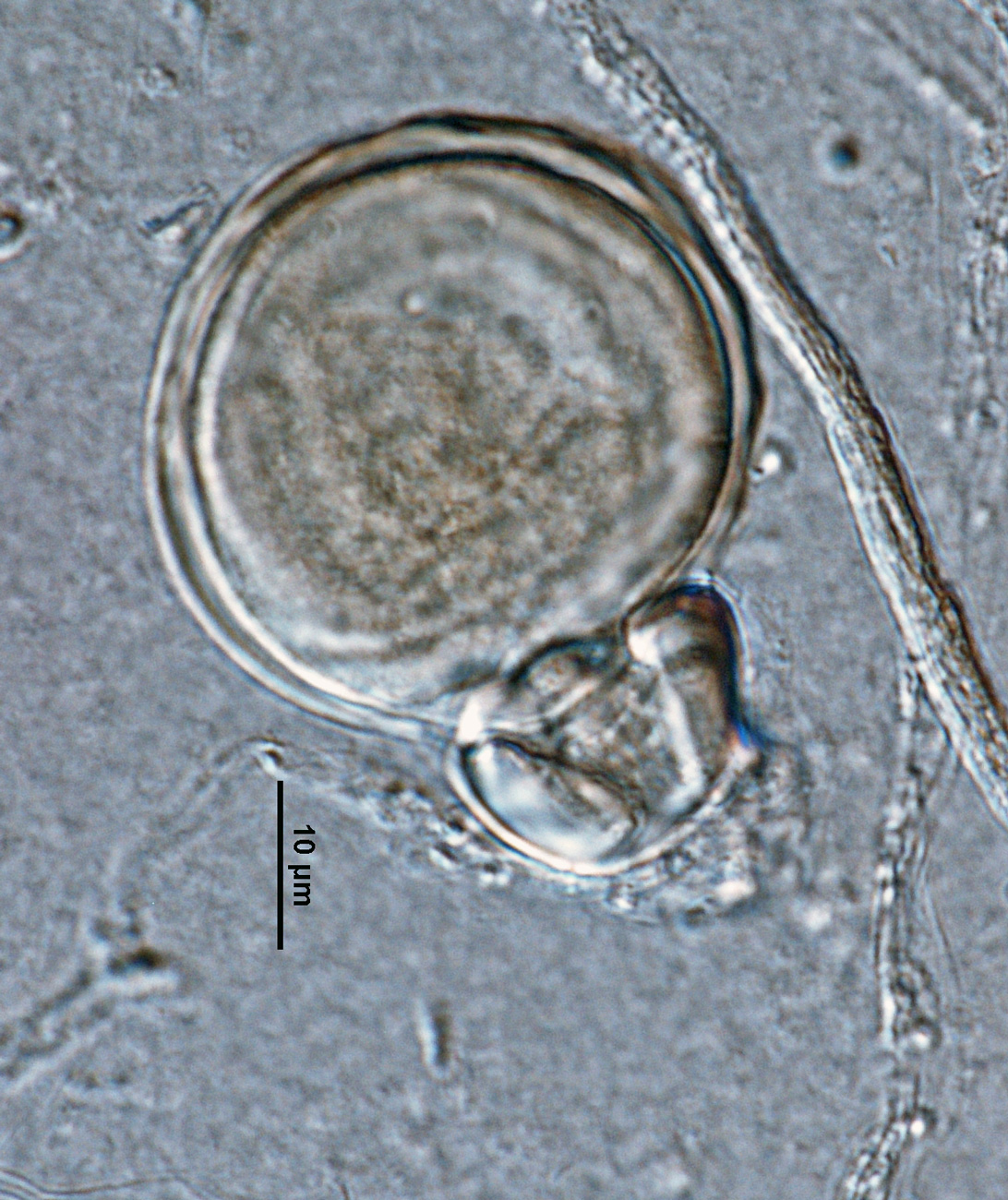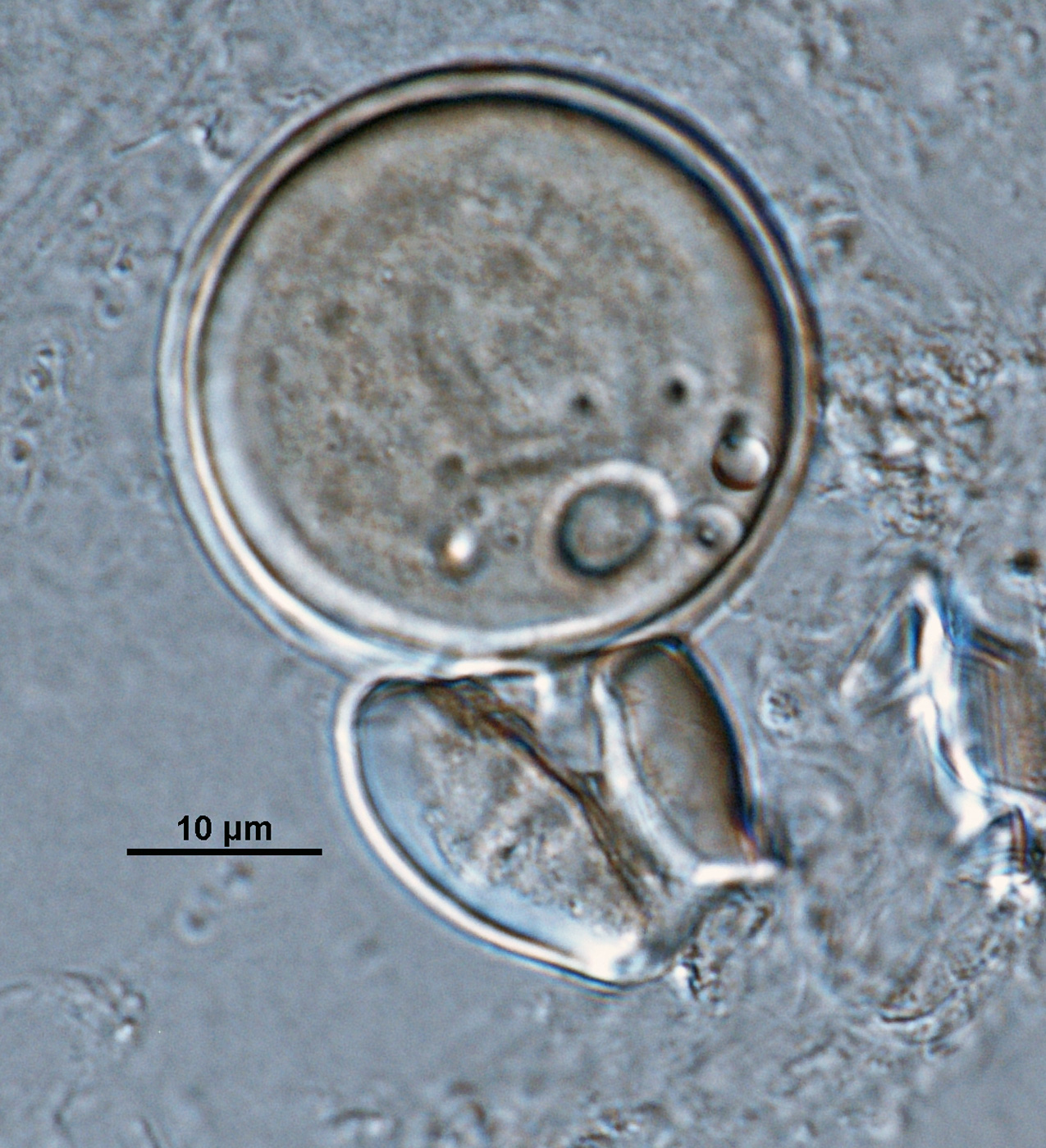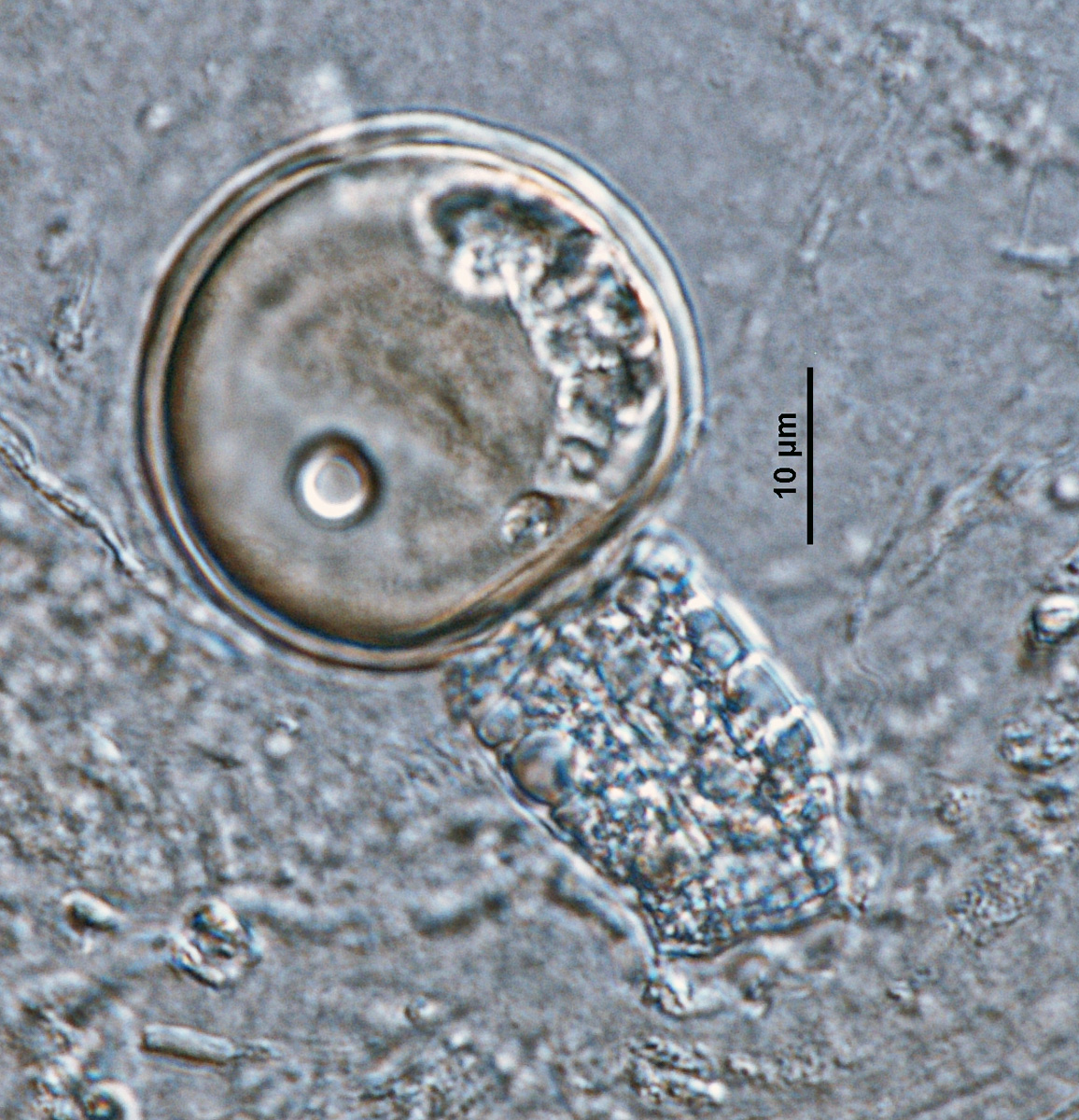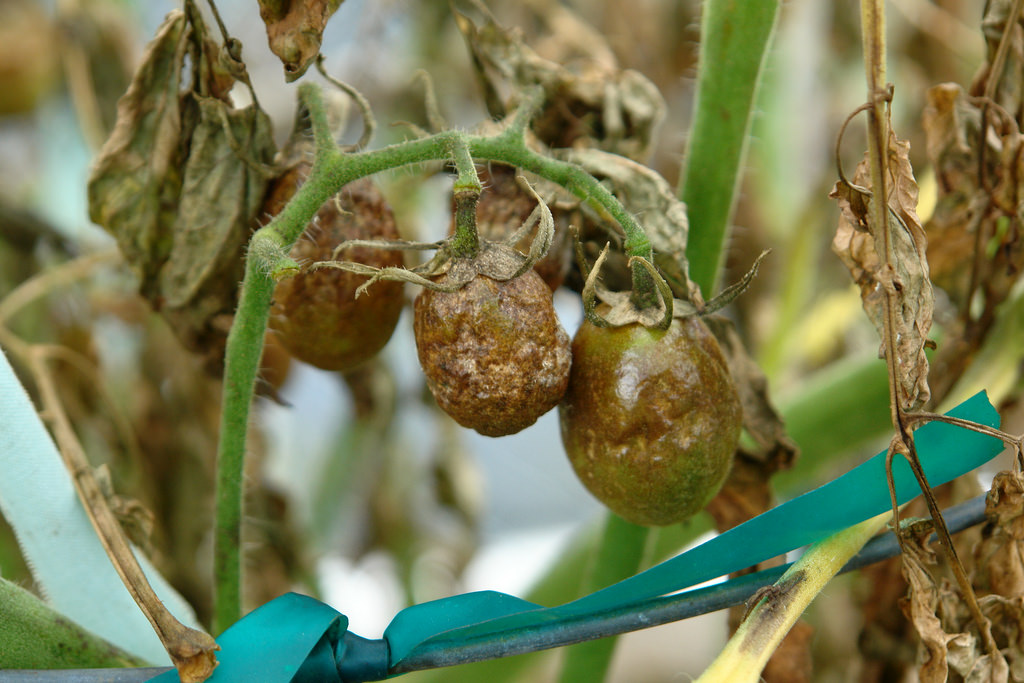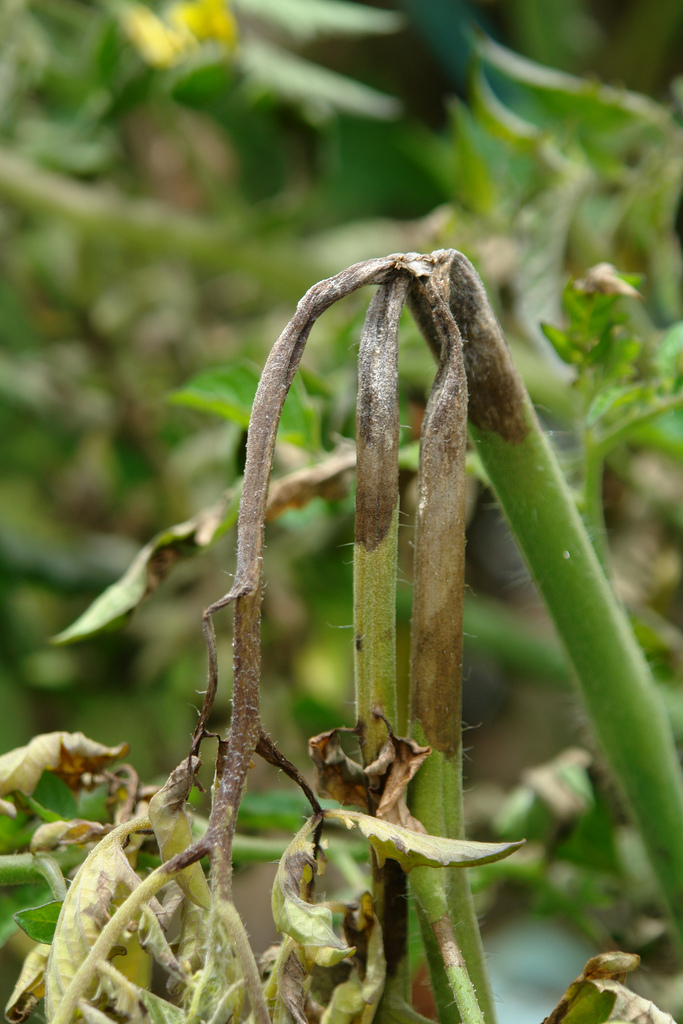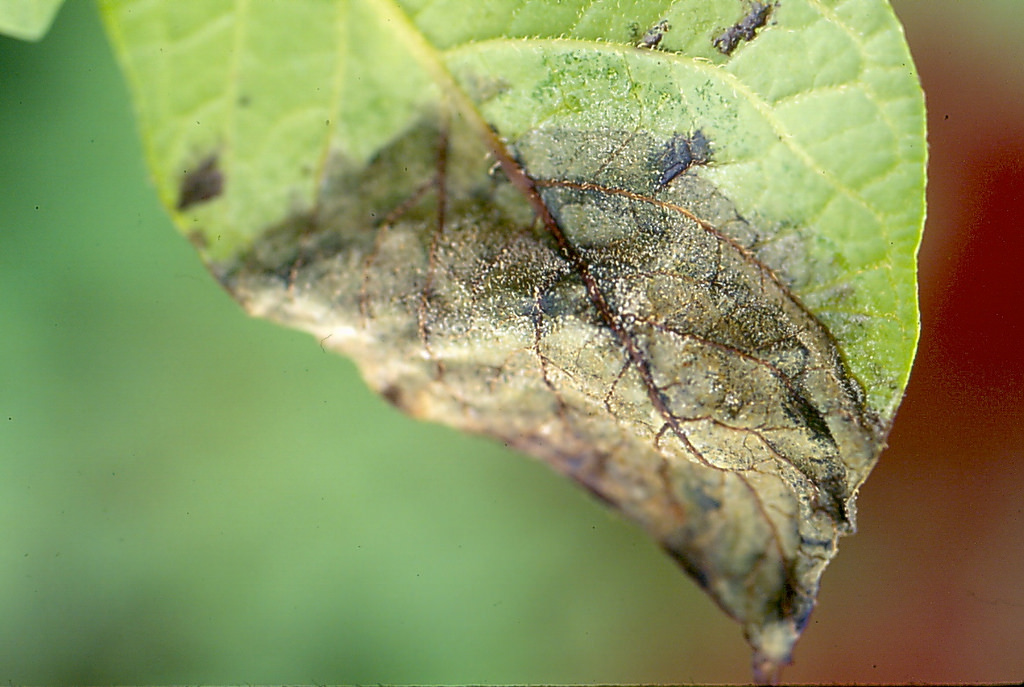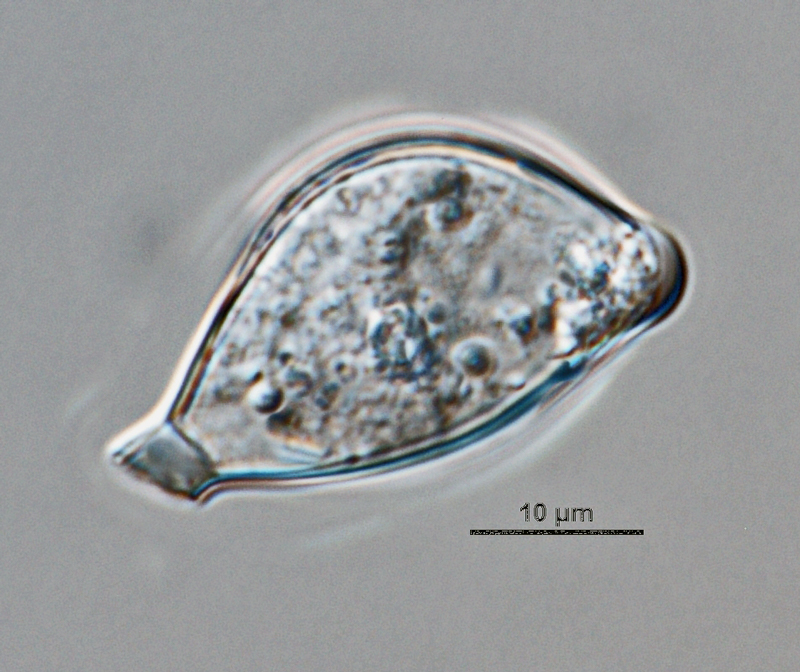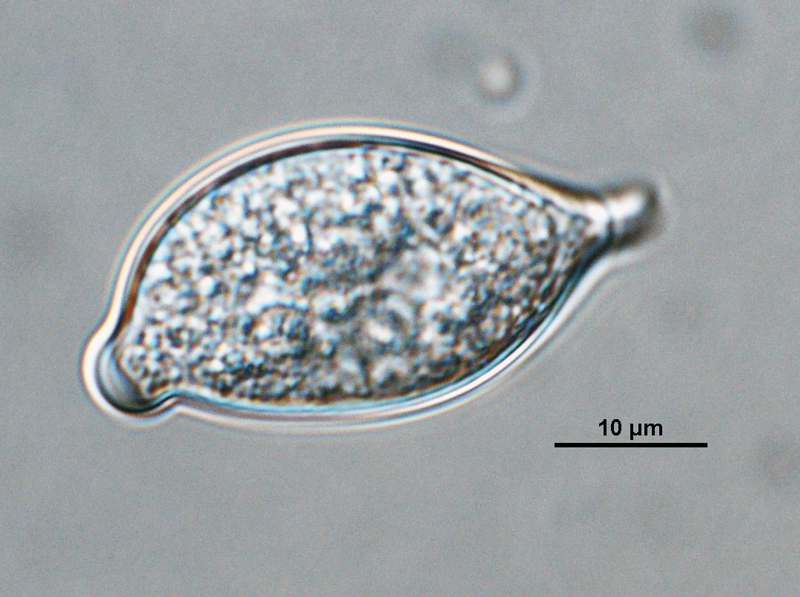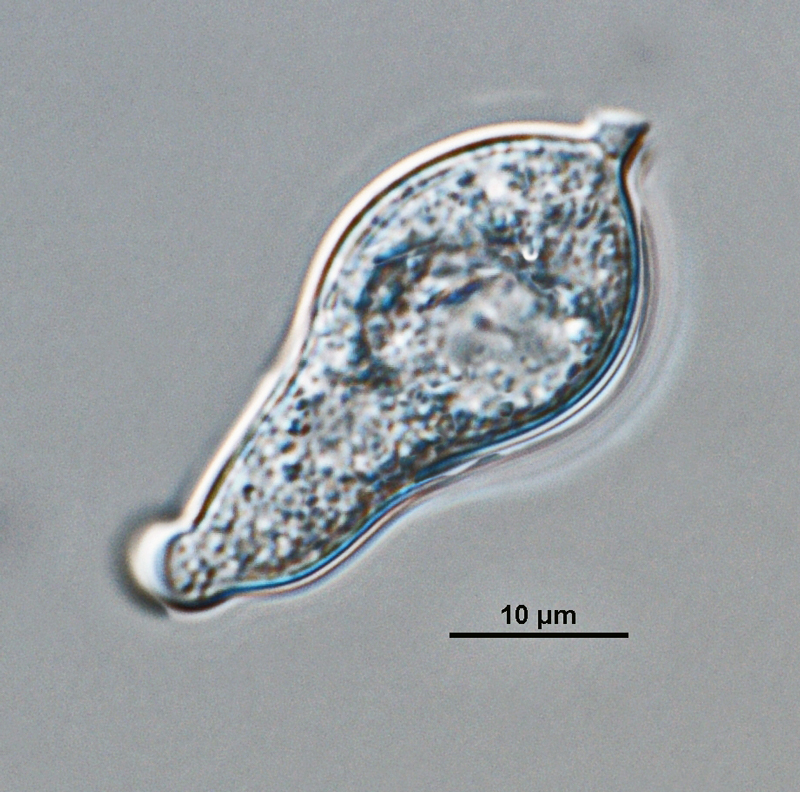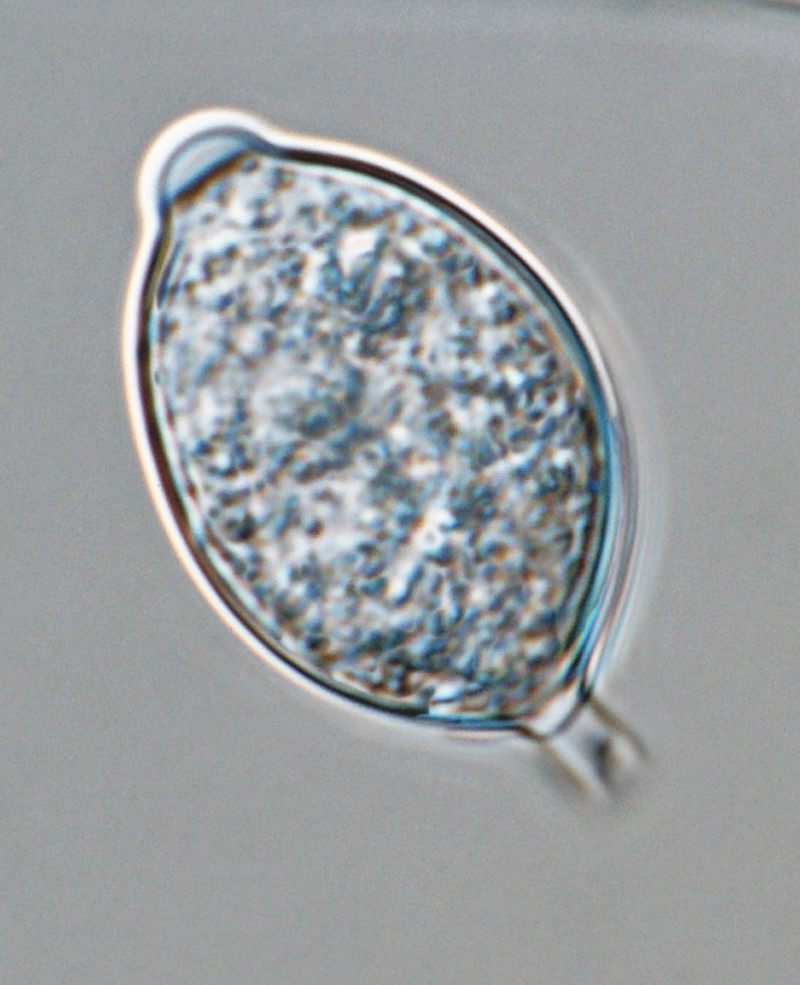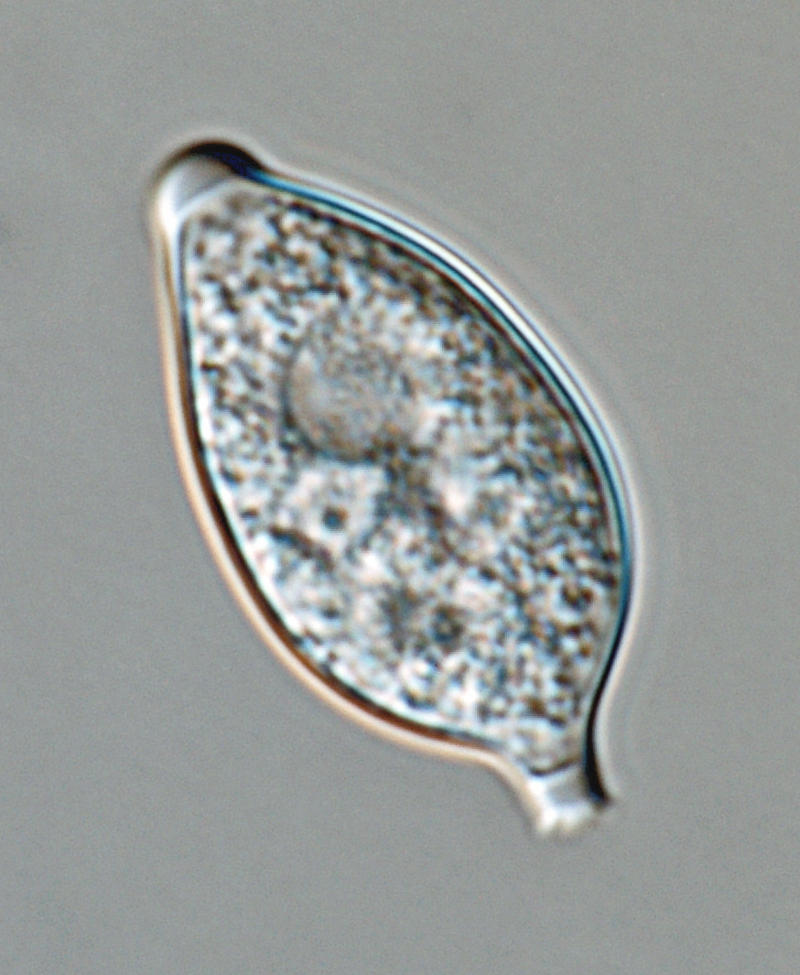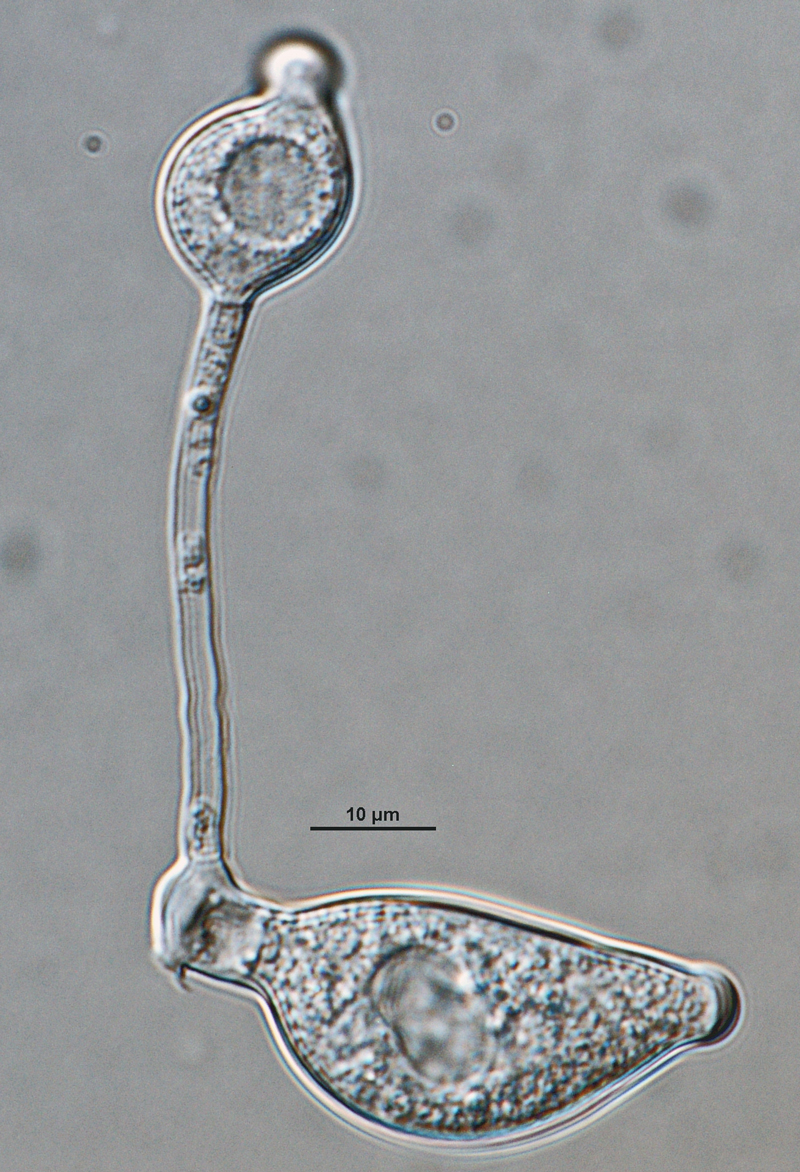Phytophthora infestans (in progress - Abad et al. 2023b)
|
Phytophthora spp. in subclade 1c: portion of the seven-loci ML phylogeny featuring the type cultures of 212 described species (by T. Bourret). Notice the position of P. infestans Ex-epitype CBS 147289, T30-4. Gloria Abad, USDA S&T.
|
|
Phytophthora spp. in subclade 1c: Morphological Tabular key (PDF) and Tabular key legends (PDF) in IDphy2 KEY SECTION. Notice the data of P. infestans Ex-epitype CBS 147289, T30-4. Gloria Abad, USDA S&T.
|
|
Phytophthora infestans (CPHST BL 142) colonies of the ex-epitype grown for 7 days on (a) V8® Agar, (b) potato dextrose agar, and (c) malt extract agar; photo by Krysta Jennings and Leandra Knight, USDA-APHIS-PPQ |
|
Phytophthora infestans (A1 x A2) heterothallic sexual phase: (a–d) smooth-walled oogonia with amphigynous antheridia and plerotic oospores; photos by Gloria Abad USDA-APHIS-PPQ. |
|
Phytophthora infestans (CPHST BL 142, selected specimen) asexual phase: (a, b) sporangia in sporangiophores; (c) sporangia external germination; (d–h) papillate sporangia with caducous short pedicels; photos by Gloria Abad, USDA-APHIS. |
|
Phytophthora infestans (A1 x A2) heterothallic sexual phase: (a–d) smooth-walled oogonium with amphigynous antheridium and a plerotic oospore; photo by Gloria Abad USDA-APHIS-PPQ. |
|
Phytophthora infestans (A1 x A2) heterothallic sexual phase: (a–d) smooth-walled oogonium with amphigynous antheridium and a plerotic oospore; photo by Gloria Abad USDA-APHIS-PPQ. |
|
Phytophthora infestans (A1 x A2) heterothallic sexual phase: (a–d) smooth-walled oogonium with amphigynous antheridium and a plerotic oospore; photo by Gloria Abad USDA-APHIS-PPQ. |
|
Phytophthora infestans (A1 x A2) heterothallic sexual phase: (a–d) smooth-walled oogonium with amphigynous antheridium and a plerotic oospore; photo by Gloria Abad USDA-APHIS-PPQ. |
|
late blight fruit rot of tomato (Lycopersicon esculentum) in a garden near Hilo, Hawaii, caused by Phyophthora infestans; photo by Scot Nelson, University of Hawaii at Manoa |
|
late blight stem collapse of tomato (Lycopersicon esculentum) in a garden near Hilo, Hawaii, caused by Phyophthora infestans; photo by Scot Nelson, University of Hawaii at Manoa |
|
late blight of potato (Solanum tuberosum), caused by Phytophthora infestans; photo by Scot Nelson, University of Hawaii at Manoa |
|
Phytophthora infestans (CPHST BL 142, selected specimen) asexual phase: semipapillate caducous sporangium with short pedicel; photo by Gloria Abad, USDA-APHIS. |
|
Phytophthora infestans (CPHST BL 142, selected specimen) asexual phase: semipapillate caducous sporangium with short pedicel; photo by Gloria Abad, USDA-APHIS. |
|
Phytophthora infestans (CPHST BL 142, selected specimen) asexual phase: semipapillate caducous sporangium with short pedicel; photo by Gloria Abad, USDA-APHIS. |
|
Phytophthora infestans (CPHST BL 142, selected specimen) asexual phase: semipapillate caducous sporangium with short pedicel; photo by Gloria Abad, USDA-APHIS. |
|
Phytophthora infestans (CPHST BL 142, selected specimen) asexual phase: semipapillate caducous sporangium with short pedicel; photo by Gloria Abad, USDA-APHIS. |
|
Phytophthora infestans (CPHST BL 142, selected specimen) asexual phase: sporangia external germination; photo by Gloria Abad, USDA-APHIS. |
Name and publication
Phytophthora infestans (Mont.) de Bary (1876)
De Bary A. 1876. Researches into the nature of the potato fungus – Phytophthora infestans. Journal of the Royal Agricultural Society XII (IX): 240–242 (pg. 240).
Nomenclature
Mycobank
Synonymy
≡ Botrytis infestans Mont., Bulletin de la Société Philomatique de Paris 13: 313 (1845) [MB226630]
≡ Peronospora infestans (Mont.) Casp. (1852) [MB179737]
Typification
Holotype for Botrytis infestans: FRANCE, from leaves of Solanum tuberosum “Sur les fanes de pomme de terre” M. Vernois, collected by Herbier Montagne, deposited by Hi. C. Montagne on 18.8.1845 FUSION94490 in Muséum d´e histoire naturelle de Paris
Ex-type: LOST
Well-authenticated specimen selected by Gloria Abad:
CPHST BL 142 (Abad) = P1381 (WPC)
Ex-type in other collections
(EEpT) CBS 147289, T30-4
Molecular identification
Voucher sequences for barcoding genes (ITS rDNA and COI) of the ex-type (see Molecular protocols page)
Phytophthora infestans isolate CPHST BL 142 (= P1381 WPC) = ITS rDNA MG865512, COI MH136906
Phytophthora infestans isolate CPHST BL 143 (= P19941 WPC) = ITS rDNA MG865513, COI MH136907
Phytophthora infestans isolate CPHST BL 19 (= P10650 WPC) = ITS rDNA MG865514, COI MH136908
Voucher sequences for Molecular Toolbox with seven genes (ITS, β-tub, COI, EF1α, HSP90, L10, and YPT1
(see Molecular protocols page) (In Progress)
Voucher sequences for Metabarcoding High-throughput Sequencing (HTS) Technologies [Molecular Operational Taxonomic Unit (MOTU)]
(see Molecular protocols page) (In Progress)
Sequences with multiple genes for ex-type in other sources
- NCBI: Phytophthora infestans CPHST BL 142
- NCBI: Phytophthora infestans CPHST BL 143
- NCBI: Phytophthora infestans CPHST BL 19
- EPPO-Q-bank: Phytophthora infestans
- BOLDSYSTEMS: Phytophthora infestans (barcoding COI & ITS)
Position in multigenic phylogeny with 7 genes (ITS, β-tub, COI, EF1α, HSP90, L10, and YPT1)
Clade clade:
a taxonomic group of organisms classified together on the basis of homologous features traced to a common ancestor
1c
Genome sequence
Phytophthora infestans strain ex-epitype T30-4. Accession genome ASM14294v1 reference, BioProject PRJNA17665, Broad Institute of MIT and Harvard (2009), Haas et al. 2009
Haas, B.J., Kamoun, S., Zody, M.C., et al. 2009. Genome sequence and analysis of the Irish potato famine pathogen Phytophthora infestans. Nature 461: 393–398.
Morphological identification
Colonies and cardinal temperatures
Colony colony:
assemblage of hyphae which usually develops form a single source and grows in a coordinated way
morphology on V8-A, PDA, and MEA with non-distinct pattern and slow growth. The minimum temperature for growth is 4°C, optimum 18°C, and maximum 24°C.
Asexual phase
Sporangia semipapillate; caducouscaducous:
pertaining to sporangia that become dislodged readily (i.e. deciduous) and separate from the sporangiophore (cf. persistent)
with short pedicelpedicel:
the hyphal base of a sporangium that remains attached after the sporangium separates, or is shed, from the sporangiophore; the pedicel may be short (< 5 µm), medium (5–20 µm), or long (> 20 µm)
; ovoid, ellipsoidellipsoid:
refers to a solid body that forms an ellipse in the longitudinal plane and a circle in cross section; many fungal spores are ellipsoidal or elliptic
or limoniform (15–48 µm long x 12–30 µm wide); some intercalaryintercalary:
positioned within a hypha (cf. terminal)
sporangia; sporangiasporangia:
sac within which zoospores form, especially when water is cooled to about 10°C below ambient temperature; in solid substrates, sporangia usually germinate by germ tubes
originated in compound sympodial sporangiophores. Hyphal swellings small, typically produced in the sporangiophores. ChlamydosporesChlamydospores:
an asexual spore with a thickened inner wall that is delimited from the mycelium by a septum; may be terminal or intercalary, and survives for long periods in soil
absent.
Sexual phase
Heterothallic. OogoniaOogonia:
the female gametangium in which the oospore forms after fertilization by the antheridium
smooth-walled (22–43 µm diam.); antheridiaantheridia:
the male gametangium; a multinucleate, swollen hyphal tip affixed firmly to the wall of the female gametangium (the oogonium)
amphyginous, elongated cylindrical or ellipsoidellipsoid:
refers to a solid body that forms an ellipse in the longitudinal plane and a circle in cross section; many fungal spores are ellipsoidal or elliptic
; oosporesoospores:
zygote or thick-walled spore that forms within the oogonium after fertilization by the antheridium; may be long-lived
predominantly plerotic (20–40 µm diam.).
Specimen(s) evaluated
Phytophthora infestans CPHST BL 142 = P1381 (World Phytophthora Collection)
CPHST BL 19 = P10650 (WPC)
CPHST BL 143 = P19941 (WPC)
Hosts and distribution
Distribution: cosmopolitan
Substrate: tubers, leaves, haulms of potato and tomato; also stems, flowers, fruits, buds on other hosts
Disease note: late blight of potato and tomato; overwinters in tubers; several races occur; also causes leaf blights and, rarely, damping off, flower, and fruit blight in a wide range of hosts
Host: Principal hosts are Solanaceae including Solanum spp. (potato) and Lycopersicon esculentum (tomato). Also occurs on hosts in 15 other genera and in ten other families (Erwin & Ribeiro 1996).
Retrieved January 31, 2018 from U.S. National Fungus Collections Nomenclature Database.
Additional references and links
De Bary A. 1876. Researches into the nature of the potato fungus – Phytophthora infestans. Journal of the Royal Agricultural Society XII (IX): 239–268 (pg. 240).
Berkeley MJ. 1846. Observations, botanical and physiological on the potato murain. J. Hortic. Soc. Lond. 1: 9–34.
Montagne C. 1845. Sur la maladie qui ravage les pommes de terre. L´Institut (Journal universel des Sciences et Sociétés savants françaises et étrangéres, 1re sect. Sciences mathématiques, physiques et naturelles) 13: 312–314.
Semal J, Joly P, Lamy D. 1982. Etude de l'herbier de Camille Montagne relatif au Phytophthora infestans (Mont.) de Bary (Botrytis infestans Mont.). Bulletin des recherches agronomiques de Gembloux 17: 295–306.
- SMML USDA-ARS: Phytophthora infestans
- EPPO Global Database: Phytophthora infestans
- Forest Phytophthoras of the world: Phytophthora infestans
- CABI Digital Library: Phytophthora infestans
- Encyclopedia of Life (EOL): Phytophthora infestans
- Index Fungorum (IF): Phytophthora infestans
- USAblight A National Project on Tomato & Potato Late Blight in the United States
- Google All Phytophthora infestans
- Google Images Phytophthora infestans
- Google Scholar Phytophthora infestans
- Google Scholar Semal J. Botrytis infestans
Fact sheet author
Z. Gloria Abad, Ph.D., USDA-APHIS-PPQ-S&T Plant Pathogen Confirmatory Diagnostics Laboratory (PPCDL), United States of America.



